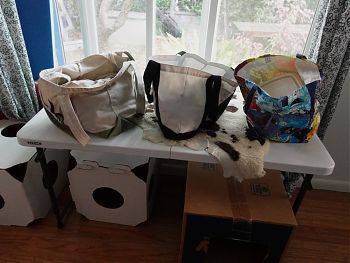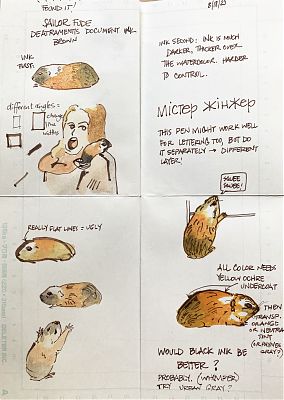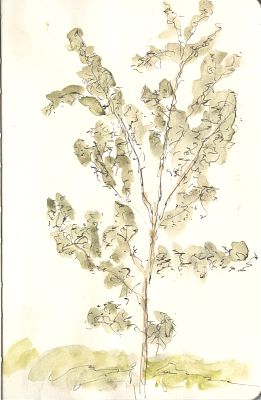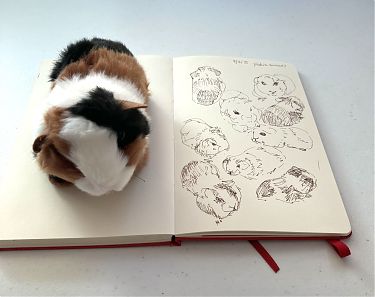24 August 25
Happy Birthday to Me
 Yesterday was my birthday. I’ve been thinking about the lettering for my Mister Ginger comic and don’t have a satisfactory italic nib. This pen writes like butter and I think it was a great choice!
Yesterday was my birthday. I’ve been thinking about the lettering for my Mister Ginger comic and don’t have a satisfactory italic nib. This pen writes like butter and I think it was a great choice!
 Numenius gave me a gift, a way to get us through some very troubled times. Keep your claws sharp….
Numenius gave me a gift, a way to get us through some very troubled times. Keep your claws sharp….
23 August 25
Guinea Pigs At The Chalkboard
Pica working on her comic about the guinea pig Mr. Ginger reminded me of a story about the great twentieth-century geneticist and evolutionary biologist, Sewall Wright. This is recounted in Jim Endersby’s book A Guinea Pig’s History of Biology which covers a lot more than just guinea pigs: rather it is a history of biology told from the point of view of the subject organisms (there are chapters on fruit flies, corn, and many other species in addition to guinea pigs).
A couple of interesting facts about guinea pigs before I get to the Sewall Wright story.
- When guinea pigs were imported from the New World the English took quite a fancy to them. Queen Elizabeth I even had one as a pet.
- They were important study animals in the discovery of vitamin C and its role in the prevention of scurvy. Like humans but unlike rats and mice, guinea pigs do not synthesize their own vitamin C, so they are good subjects for this topic.
- The eminent twentieth-century British biologist JBS Haldane studied guinea pigs for a while because his sister took up keeping guinea pigs after she developed an allergy to horses. (They were an upper-class family.) Their lawn didn’t have croquet hoops or tennis nets, rather there were about 300 guinea pigs running loose behind the fencing. The genetics experiments came to a tragic end in the penultimate generation when a friend’s fox terrier jumped the front gate and frightened all the guinea pigs to death. (Incidentally, Haldane was a British communist who like many of his compatriots including George Orwell went over to Spain to fight the Fascists).
Together with JBS Haldane and R.A. Fisher, Sewall Wright (1889-1988) was one of the three key figures in developing the mathematical theory of evolution in the first half of the twentieth century. I first heard of him in my undergrad courses around 1982 and 1983 on population genetics and evolutionary biology. Wright was still alive at that point. I more recently ran across him while reading Judea Pearl and Dana Mackenzie’s popularization of the theory of causal inference, The Book of Why. Wright in 1921 developed the mathematical technique of path analysis, which is an important precursor to causal inference theory.
Wright fell into working with guinea pigs because he was offered a position as a graduate student to be a caretaker of a research colony of the animals, and he kept working with them for most of his career. The following story about Wright is apocryphal, and according to his biographer William Provine the story isn’t true, but is fun to relate nonetheless. As background, although Wright was incredibly conscientious and generous with his time, he was not a very good lecturer. This is quoted from an interview with a student of Wright’s, the paleontologist Robert Sloan:
I didn’t see this, but my friend and partner, Ernie Lundelius, who was one of the groomsmen in my wedding, describes a case where Wright brought in a guinea pig. He was displaying the guinea pig and showing some of the variations in coat color. This particular guinea pig was somewhat more fractious than usual and was scurrying around on the desk and was not about to be quiet. When Wright worked at the blackboard, traditionally he tucked an eraser in his left armpit. And to keep the guinea pig quiet, he tucked the guinea pig in his left armpit. And when he was through and ready to erase some space so that he could put the next equation down, he reached for the eraser and grabbed the guinea pig and started to erase the blackboard with a squeaking guinea pig. Of course, this was one of the tales that went around among all the students of evolution. Whether they had been there or not, I doubt it ever got into print. It deserves to be there, as part of at least the bibliography of Sewall Wright.
22 August 25
A Big Part of Our Lives
 Feathers of Hope was neglected for a long while but we’re both glad to be back to our alternating daily posting practice. One of the things we never did here was introduce the no-longer new cats. Charlie and Diego both died before we moved into town; we had been living here for a few months and decided we needed cats back in our lives.
Feathers of Hope was neglected for a long while but we’re both glad to be back to our alternating daily posting practice. One of the things we never did here was introduce the no-longer new cats. Charlie and Diego both died before we moved into town; we had been living here for a few months and decided we needed cats back in our lives.
The SAWgust prompt today was “Companions,” a pet tax asking about our pets. Here’s my entry from today, along with the photo at left:
Two gray cats that were rescued as kittens from under a pallet behind Walmart when it was blisteringly hot. Very different personalities… Winston is big and muscular, with a meow that is much higher and pitiful than his ballbuster persona would imply, and Esmerelda aka Esme aka Missy who always always looks scruffy even after you’ve brushed her.
ETA this was taken in winter; there is no way they’d be this close today even in the coolish pre-dawn hours….
21 August 25
The Domestic LLM
One of the reasons I built my own computer recently was to have a machine available considerably more powerful than my laptop so that I can learn about and experiment with current technology. I am now playing around with large language models (aka LLMs) which is the key technology behind ChatGPT and its rivals. As widely recognized, these state-of-the-art systems consume enormous amounts of resources to build and keep running. What’s less widely known is that smaller versions of these same models are continually being released as freely available downloads for community experimentation, research, and development. Many of these open models are still far too large to run at home, but many others will run happily on ordinary home computers (albeit the more powerful your graphics card is, the better off you are). I’ve been learning a great deal experimenting with these. Some of the things I’ve learned are:
- There is an enormous amount of development going on across this whole space. There are tools and approaches available now that would have been really useful to me professionally a year-and-a-half ago.
- Nobody really understands how this technology works. An example: I asked my local LLM to write a poem in iambic tetrameter about the cat sleeping on his cat bed in my office. After some nudging (the first version was in iambic pentameter, but I told it to try again), it succeeded in producing some doggerel with the correct scansion. How did the system do this? We have no idea. We cannot point to a “metrical poetry” module within the system — rather, we are seeing emergent behavior.
- It is straightforward to set up an LLM system (even one at home) to let you conversationally ask questions and get natural language responses about a body of documents. (My test corpus has been a set of 80 or so conservation management plans from California). What is not at all straightforward is getting responses that are reliably accurate. Enormous amounts of engineering effort across every domain is being expended right now to build reliable conversational systems, but for now this is both very challenging and expensive.
- It is not clear what the important real-world applications of local LLM systems (i.e. ones you can run on a laptop or desktop) are going to be. There are a great deal of privacy benefits to them, since you can avoid shipping your sensitive documents off to Meta/Google/OpenAI etc. for LLM-based analyses, but will the local systems be powerful enough to conduct the analyses? One application of much interest to me is extracting structured information from unstructured or semi-structured text documents. This has been a challenge I’ve been pondering for quite a number of years, and LLM-based techniques for doing this are just starting to emerge.
20 August 25
Material
 The good folks at SAWgust have been providing prompts daily to get us thinking about our process. I’ve sometimes answered prompts but I’ve ALWAYS thought about them; they’re very interesting. Today’s was #material: what materials do we use and why? I decided to draw it on one of my materials that isn’t pictured here (Procreate on my iPad). And it’s all from memory, since Winston was sprawled across the kitchen table where these materials all are.
The good folks at SAWgust have been providing prompts daily to get us thinking about our process. I’ve sometimes answered prompts but I’ve ALWAYS thought about them; they’re very interesting. Today’s was #material: what materials do we use and why? I decided to draw it on one of my materials that isn’t pictured here (Procreate on my iPad). And it’s all from memory, since Winston was sprawled across the kitchen table where these materials all are.
Last night I had a call with Mr. Ginger’s owner, and hoo boy there is a lot more to this story. Good and bad. The good: Mister Ginger is still alive and well and living in Kharkiv (and he has a girlfriend); the bad: this has been traumatic for him, retelling this story for me. But A. did say that he thought Mr. Ginger helped him through some very hard times, which is great to hear because it’s the actual punchline — simply giving comfort to people in a war zone is heroic enough.
19 August 25
Daily Photo - Grocery Bags
 I’ve been keeping up my new practice of documenting my life via a daily photograph. Here are the grocery bags lined up prior to today’s food co-op run.
I’ve been keeping up my new practice of documenting my life via a daily photograph. Here are the grocery bags lined up prior to today’s food co-op run.
18 August 25
Matching the Medium to the Message
 On Saturday I attended the SAWgust halfway point call. I had a question about how others organized their composition process if the final was going to be analog; mostly I work on paper then go digital. But for this Ukraine project it seems analog is a good way to go.
On Saturday I attended the SAWgust halfway point call. I had a question about how others organized their composition process if the final was going to be analog; mostly I work on paper then go digital. But for this Ukraine project it seems analog is a good way to go.
I’d done some sketches with a fountain pen but it has a fine nib and when reduced down it maybe too fine a line. I looked for and found my Sailor Fude pen, a fountain pen with a bent nib that can give you at least three different thicknesses. I think I can get this to work. I still have some fine-tuning to do but am pretty set on this course.
Someone said they just redrew and redrew panels until they were right. Someone else said when using watercolor they used a camera rather than a scanner. Another helpful suggestion was to write the names of the materials, paints, brushes and pens on the back of the work so if you revisit it a year later you have some hope of matching it.
Meanwhile it’s looking like I might do the whole section before the invasion in full color, moving to monochrome afterwards except for the guinea pig… The paper is Deleter A Comic Book Paper size B5, which is not as thick as Bristol board, takes a good wash, and is very pen-friendly.
17 August 25
Daily Sketch - Young Oak
 For today’s weekend tree sketch I ventured out on bicycle to the local arboretum where to no surprise there are many trees. I sketched this young oak with De Atramentis Urban Gray ink and used Derwent Graphitint pan paints for the wash. I like the Derwent Graphitint pan set a lot. The principle of the Graphitints (both in pencil and pan paint form) is that they are watercolor pigments mixed with graphite particles which mutes the colors a lot. Using the pan set I find I can mix a lot of realistic greens, and muted sketches work well at times.
For today’s weekend tree sketch I ventured out on bicycle to the local arboretum where to no surprise there are many trees. I sketched this young oak with De Atramentis Urban Gray ink and used Derwent Graphitint pan paints for the wash. I like the Derwent Graphitint pan set a lot. The principle of the Graphitints (both in pencil and pan paint form) is that they are watercolor pigments mixed with graphite particles which mutes the colors a lot. Using the pan set I find I can mix a lot of realistic greens, and muted sketches work well at times.
16 August 25
Almost a Real Guinea Pig
 I’ve now completed a very incomplete first draft of the script for my Mister Ginger comic. There will need to be quite a bit of work on the script and also on the drawings… but to help with the latter, I ordered a plushie, pictured at left, and set about doing some sketches.
I’ve now completed a very incomplete first draft of the script for my Mister Ginger comic. There will need to be quite a bit of work on the script and also on the drawings… but to help with the latter, I ordered a plushie, pictured at left, and set about doing some sketches.
Drawing live guinea pigs is obviously better, but a) I don’t have one, b) if I did, the cats would kill it, c) if I go to the pet store, the animals are almost at ground level which makes it hard to get anything other than a bird’s eye view. So this plushie, while not perfect, at least allows me the luxury of placing at eye level and even higher, this way and that, 3/4 view and from behind. I am still drawing on reference photos but this will allow me to stage the drawings in my comic better.
15 August 25
Slow Focus
 One thing to learn from Saul Leiter is to not be afraid to experiment and to embrace imperfections in the resulting images. In this vein is playing around with vintage lenses which tend to be optically more interesting than their modern ilk. In my YouTube feed a couple days ago there popped up a video about the Helios 44-2 lens and I immediately thought oh! I have one of those. Time to take it out for a whirl.
One thing to learn from Saul Leiter is to not be afraid to experiment and to embrace imperfections in the resulting images. In this vein is playing around with vintage lenses which tend to be optically more interesting than their modern ilk. In my YouTube feed a couple days ago there popped up a video about the Helios 44-2 lens and I immediately thought oh! I have one of those. Time to take it out for a whirl.
The Helios 44-2 is a 58mm lens that was made in large numbers in the Soviet Union. It has a good reputation among vintage lens aficionados because as being a lens with character known for its “swirly bokeh”. I happen to have one; it was the lens that came with my first SLR, an all-manual Zenit. It is labelled “Made in U.S.S.R.” on the lens barrel. Sometime back, I picked up an adapter so that I could mount it on my micro four-thirds interchangeable lens camera (a Panasonic GX-85). For micro four-thirds lenses, their effective focal length (in full frame i.e. 35mm format terms) is twice that of their actual focal length. In other words, a 58mm lens, one with a normal focal length on a 35mm film camera, works out to be a moderate telephoto (effective focal length 116mm) on a micro four-thirds camera. The Helios 44-2 is also a fully manual lens: autofocus was many years in the future.
Anyway, on my late afternoon walk yesterday I took the GX-85 with the Helios 44-2 mounted to it. Focusing manually is a familiar experience, but it’s not one we do much of any more! It forces one to take one’s time, especially since the Helios 44-2 is a moderate telephoto on this camera. At right is one of the images I got on this outing.
